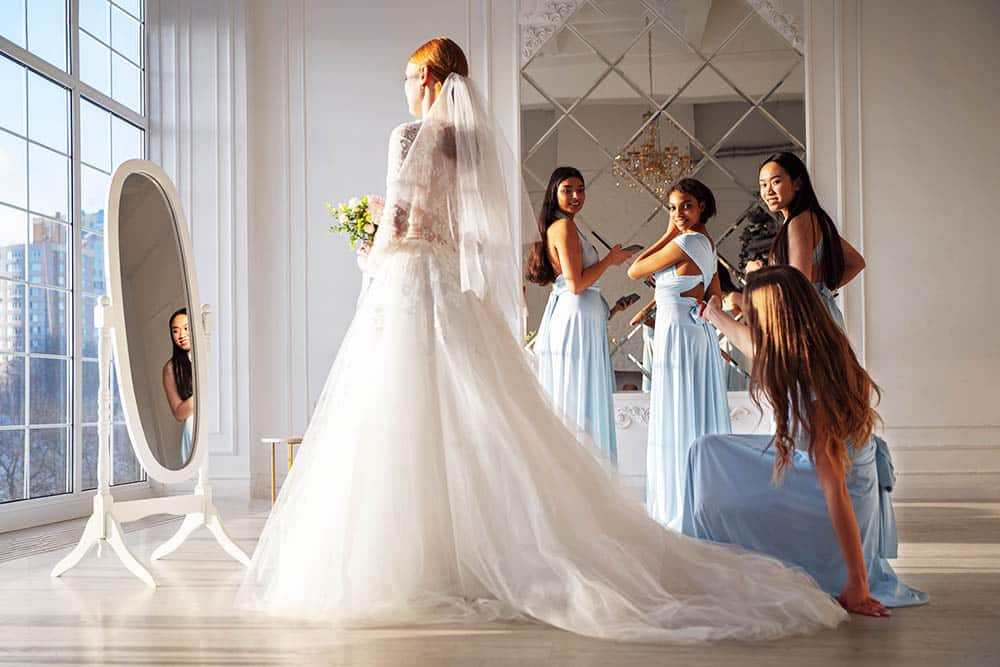Wedding season is approaching fast, and if you’re planning to tie the knot anytime soon, you’re probably already feeling the pressure to find the perfect wedding dress. After all, your wedding day is a once-in-a-lifetime event, and you want to look and feel your best for the occasion. From the gown’s fabric to its silhouette, every detail counts when it comes to finding the perfect wedding dress.
There’s no need to panic, though. In this article, we’ll give you some tips on how to choose the right wedding dress and unleash your inner bridezilla with grace and confidence.
Determine your Budget
Before you start looking for the perfect wedding dress, you need to decide how much you’re willing to spend. Be realistic about your budget and don’t forget to factor in the cost of alterations, accessories, and other essentials. You can find beautiful wedding dresses at any price point, but be aware that some styles and fabrics are more expensive than others.
Consider the Theme and Location
Your wedding dress should be appropriate for the theme and location of your wedding. For example, if you’re having a beach wedding, a heavy ball gown may not be the most practical choice. Similarly, if you’re having a traditional church wedding, a short, casual dress may not be the best fit.
Find the Right Silhouette
The silhouette of your wedding dress is one of the most important factors to consider. The right silhouette can flatter your body type and make you look and feel confident and comfortable. Here are some common wedding dress silhouettes:
- A-line: This silhouette flares out from the waist, resembling the shape of an «A.» It’s a classic and versatile style that looks great on most body types.
- Ball gown: This silhouette is defined by a fitted bodice and a full skirt that flares out at the waist. It’s a formal and traditional style that works well for all body types, especially if you’re trying to create a dramatic look.
- Mermaid: This silhouette hugs the body from the top to the knee, then flares out at the bottom. It’s a sexy and modern style that’s ideal for brides with an hourglass figure.
- Sheath: This silhouette is straight and narrow, skimming the body’s curves without any excess fabric. It’s a minimalist and chic style that looks great on petite brides.
Choose the Right Fabric
The fabric of your wedding dress can impact how comfortable you feel on your wedding day. Some fabrics are lighter and airier, while others are heavier and more structured. Here are the most common fabrics used in wedding dresses:
- Satin: This fabric is smooth and shiny, with a high sheen that looks luxurious and glamorous. It’s a classic choice for formal weddings.
- Lace: This fabric is romantic and feminine, with delicate patterns and a sheer texture. It’s a popular choice for bohemian and vintage weddings.
- Tulle: This fabric is light and airy, with a delicate and ethereal look that’s ideal for outdoor and beach weddings.
- Chiffon: This fabric is flowy and lightweight, with a soft and delicate texture that’s perfect for warmer weather and destination weddings.
Accessorize with Care
Once you’ve found your perfect wedding dress, it’s time to accessorize it with care. The right accessories can complete your bridal look and add a touch of personality and style. But be careful not to go overboard. Remember that less is often more when it comes to bridal accessories.
Here are some common bridal accessories to consider:
- Veil: This classic accessory can add a touch of elegance and drama to your bridal look. Choose a veil that complements your dress and face shape.
- Jewelry: Choose jewelry that complements your wedding dress and personal style. Simple pieces like studs, a necklace, and a bracelet are always a good choice.
- Shoes: Your wedding shoes should be comfortable, stylish, and appropriate for the location of your wedding. If you’re having an outdoor wedding, opt for comfortable wedges or sandals.
Don’t Forget the Alterations
Once you’ve found your dream wedding dress, don’t forget to have it altered to fit your body perfectly. A well-fitted wedding dress can make all the difference in how you look and feel on your wedding day. Be sure to schedule your alterations in advance and bring the appropriate undergarments and shoes to your fittings.
Summary
Choosing the perfect wedding dress can be a daunting task, but with the right guidance and preparation, it can also be a fun and exciting experience. Remember to consider your budget, theme, and location when selecting your wedding dress, and choose a silhouette and fabric that flatter your body type and reflect your personal style. Accessorize with care, and don’t forget to schedule alterations to ensure a flawless fit. With these tips in mind, you’ll be able to unleash your inner bridezilla with confidence and grace on your special day.
- Why Venture Capital is Essential for Startups: The Key to Unlocking Success - 28 de mayo de 2023
- Revolutionize Your Business with E-commerce: The Ultimate Guide to Success - 28 de mayo de 2023
- Why Patents are Crucial for Protecting Innovation and Driving Economic Growth - 28 de mayo de 2023
